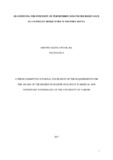| dc.description.abstract | The development and spread of resistance among local mosquito vectors to the major classes of insecticides used in Long Lasting Insecticidal Nets (LLINs) and Indoor Residual Spraying (IRS) poses a major challenge to malaria vector control programs. The main methods of evaluating insecticide resistance in malaria vector include the WHO tube bioassay and CDC bottle assays. The main weakness in these methods is that they measure resistance at fixed standardized insecticide concentrations and not variable insecticide doses to determine intensity of resistance. However the CDC bottle assay using different insecticide dosages has proved applicable in ascertaining the intensity of resistance. This study determined the status and intensity of permethrin resistance and investigated the efficacy of commonly used LLINs (PermaNet® 2.0, PermaNet® 3.0 and Olyset®) against 3-5 day old female Anopheles mosquitoes from four sub-counties; Teso, Bondo, Rachuonyo and Nyando in Western Kenya. Two sentinel sites were selected per sub-county; Akiriamasi and kaliwa in Teso, Barkanyango and Omia Mwalo in Bondo, Kobuya and Kamenya in Rachuonyo and lastly Kochogo and Ahero in Nyando. The mosquitoes were exposed to three different assays; WHO susceptibility test, CDC bottle assay and cone bioassay. For the intensity of insecticide resistance the mosquitoes were exposed to ×1(21.5μg/ml), ×2(43μg/ml), ×5 (107.5μg/ml) and ×10(215μg/ml) doses of permethrin using CDC bottle assays. Mortality after 24h was recorded for WHO assays; time to knockdown was monitored for the bottle assays while both mortality and knockdown was used for the cone assay. All the mosquito samples were identified to species level using standard polymerase chain reaction. It is only in Kaliwa, Teso were An. gambiae s.s was the major species while the rest were An. arabiensis. Resistance to permethrin was confirmed in Teso, Bondo, Rachuonyo and one site from Nyando while there was likelihood of resistance in Kochogo, Nyando. Intensity of permethrin resistance was highest in Barkanyango, Bondo with 84% knockdown at the 30 minutes diagnostic time when exposed to the ×10 dose. Mortality for the nets was (0-39) %, (12-88) % and (26-89) % for Olyset, PermaNet 2.0 and PermaNet 3.0 respectively. The efficacy of the nets was greatly reduced in Bondo and Teso. Results from this study shows that there was confirmed resistance in all the sites: However, intensity assays were able to differentiate Bondo and Teso as the sites with the highest levels of resistance, which coincidentally were the two with reduced net efficacy. There was a reduced efficacy of nets in areas with high resistance portraying that at certain intensities of resistance, vector control using LLINs may be compromised. Therefore it is necessary to incorporate intensity assays in order to determine the extent of threat that resistance poses to malaria control. | en_US |



